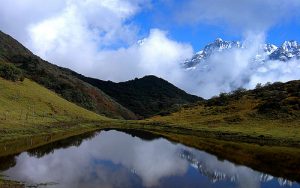India’s environment ministry is planning to reduce the protected area around national parks and sanctuaries in Sikkim in order to clear controversial hydropower projects, according to environmentalists in the Himalayan state. In the process, it has bypassed the National Board for Wildlife (NBWL) – which is under the same ministry but is chaired by the Prime Minister – and has ignored an order of the country’s Supreme Court, the environmentalists allege.
The ministry of environment and forests (MOEF) has issued a draft notification by which the width of the buffer zone – where major projects are not permitted – around Sikkim’s lone national park and four wildlife sanctuaries has been reduced from 10 kilometres to 25-200 metres. The notification is now available for feedback from people, and unless it is changed, it is supposed to come into effect this April.
Criticising the move, Tseten Tashi Bhutia – convenor of the NGO Sikkim Bhutia Lepcha Apex Committee (SIBLAC), which is fighting a legal battle against the Tashiding hydroelectric project in Sikkim High Court – said, “We have been demanding earmarking of an eco-sensitive zone of up to 10 kilometres around protected areas under the Supreme Court order. Now if the government itself ridicules NBWL’s warning report and manipulates its own laws, what can a citizen of democratic India say?”
Sikkim is a global biodiversity hotspot, home to endangered animals such as snow leopard, clouded leopard, red panda and Great Tibetan Sheep. The state also has a huge repository of medicinal plants.
“We strongly protest this notification of the MOEF and will respond officially. They can’t bulldoze their vested interest, damaging our fragile environment,” Bhutia told thethirdpole.net. “Already a lot of damage has been done, we might take appropriate legal recourse after consultations, if the notification is not altered or withdrawn.”
On September 28 last year, SIBLAC and another group called Save Sikkim filed a complaint at the local police station against Shiga Energy Private Ltd, developer of the 97 megawatt Tashiding project. They accused the company of cheating, distortion of facts and violation of environmental norms and of the Supreme Court order. The groups also have an ongoing public interest litigation (PIL) suit in the Sikkim High Court.
The proposed Tashiding project site is about 5 kilometres from the buffer zone of the Khangchendzonga Biosphere Reserve, and within 10 kilometres of the Fambong La Wildlife Sanctuary. So, until the union ministry proposed to change the rules, NBWL clearance of the project would have been mandatory. Khangchendzonga Biosphere Reserve is down the slopes of the world’s third highest peak, by the same name.
In the 2006 case brought by the NGO Goa Foundation against mining around protected forests in Goa, the Supreme Court ordered that any project falling within 10 kilometres of a national park or a wildlife sanctuary has to be endorsed by the standing committee of the NBWL unless a different site-specific protection ring is declared for each of these national parks and sanctuaries. This verdict was supposed to have set a precedent.
The NBWL standing committee warned the ministry in August 2013 that at least six dams in Sikkim were coming up without the mandatory clearance. These include the proposed Teesta V project, and the ongoing Teesta III, Dik Chu, Panan, and Tashiding projects The ministry is also considering another five projects that will be built close to protected areas.
Tseten Lepcha, president of Affected Citizens of Teesta (ACT) – an organisation of people displaced or affected by the dam projects – told thethirdpole.net, “Moves like this make one wonder as to what would become the fate of the law abiding citizens of this country; when the government elected by the people are resorting to such blatant violations of the existing laws of the land, and are circumventing them to serve vested interests, it is a shame at the least.”
ACT members sat on a relay-hunger strike in 2005-06 to protest against the hydropower projects. “We will take up the issue officially,” said Lepcha.
Officials in the forest department of the state government of Sikkim declined to speak on the issue.
